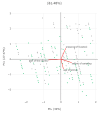Detection of Gastrointestinal Pathogens with Zoonotic Potential in Horses Used in Free-Riding Activities during a Countrywide Study in Greece
- PMID: 39272351
- PMCID: PMC11394066
- DOI: 10.3390/ani14172566
Detection of Gastrointestinal Pathogens with Zoonotic Potential in Horses Used in Free-Riding Activities during a Countrywide Study in Greece
Abstract
The objectives of this study were (a) to detect zoonotic gastrointestinal pathogens in faecal samples of horses using the FilmArray® GI Panel and (b) to identify variables potentially associated with their presence. Faecal samples collected from 224 horses obtained during a countrywide study in Greece were tested by means of the BioFire® FilmArray® Gastrointestinal (GI) Panel, which uses multiplex-PCR technology for the detection of 22 pathogens. Gastrointestinal pathogens were detected in the faecal samples obtained from 97 horses (43.3%). Zoonotic pathogens were detected more frequently in samples from horses in courtyard housing (56.0%) than in samples from horses in other housing types (39.7%) (p = 0.040). The most frequently detected zoonotic pathogens were enteropathogenic Escherichia coli (19.2% of horses) and Shiga-like toxin-producing E. coli stx1/stx2 (13.8%). During multivariable analysis, two variables emerged as significant predictors for the outcome 'detection of at least one zoonotic pathogen in the faecal sample from an animal': (a) the decreasing age of horses (p = 0.0001) and (b) the presence of livestock at the same premises as the horses (p = 0.013). As a significant predictor for the outcome 'detection of two zoonotic pathogens concurrently in the faecal sample from an animal', only the season of sampling of animals (autumn) emerged as significant in the multivariable analysis (p = 0.049). The results indicated a diversity of gastrointestinal pathogens with zoonotic potential in horses and provided evidence for predictors for the infections; also, they can serve to inform horse owners and handlers regarding the possible risk of transmission of pathogens with zoonotic potential. In addition, our findings highlight the importance of continuous surveillance for zoonotic pathogens in domestic animals.
Keywords: Campylobacter; Cryptosporidium; Escherichia coli; FilmArray; Giardia; Norovirus; Salmonella; Vibrio; Yersinia; diarrhoea; donkey; horse; zoonotic infection.
Conflict of interest statement
The authors declare no conflicts of interest.
Figures






Similar articles
-
Detection of Zoonotic Gastrointestinal Pathogens in Dairy Sheep and Goats by Using FilmArray® Multiplex-PCR Technology.Microorganisms. 2022 Mar 25;10(4):714. doi: 10.3390/microorganisms10040714. Microorganisms. 2022. PMID: 35456765 Free PMC article.
-
Prospective evaluation of different faecal preservation media for travellers' diarrhoea diagnostic application with multiplex PCR BioFire FilmArray in resource-limited settings.J Med Microbiol. 2025 Jan;74(1):001954. doi: 10.1099/jmm.0.001954. J Med Microbiol. 2025. PMID: 39887178 Free PMC article.
-
Multicenter evaluation of the BioFire FilmArray gastrointestinal panel for etiologic diagnosis of infectious gastroenteritis.J Clin Microbiol. 2015 Mar;53(3):915-25. doi: 10.1128/JCM.02674-14. Epub 2015 Jan 14. J Clin Microbiol. 2015. PMID: 25588652 Free PMC article.
-
Mapping of aetiologies of gastroenteritis: a systematic review and meta-analysis of pathogens identified using a multiplex screening array.Scand J Gastroenterol. 2020 Dec;55(12):1405-1410. doi: 10.1080/00365521.2020.1839128. Epub 2020 Nov 4. Scand J Gastroenterol. 2020. PMID: 33147077
-
Accuracy and comparison of two rapid multiplex PCR tests for gastroenteritis pathogens: a systematic review and meta-analysis.BMJ Open Gastroenterol. 2021 Feb;8(1):e000553. doi: 10.1136/bmjgast-2020-000553. BMJ Open Gastroenterol. 2021. PMID: 33648983 Free PMC article.
References
-
- Dwyer R. Equine zoonoses: Consequences of horse-human interactions. In: Sing A., editor. Zoonoses-Infections Affecting Humans and Animals. Springer; Dordrecht, The Netherlands: 2015.
-
- Ruple-Czerniak A.A., Aceto H.W., Bender J.B., Paradis M.R., Shaw S.P., Van Metre D.C., Weese J.S., Wilson D.A., Wilson J., Morley P.S. Syndromic surveillance for evaluating the occurrence of healthcare-associated infections in equine hospitals. Equine Vet. J. 2014;46:435–440. doi: 10.1111/evj.12190. - DOI - PubMed
LinkOut - more resources
Full Text Sources
Research Materials

